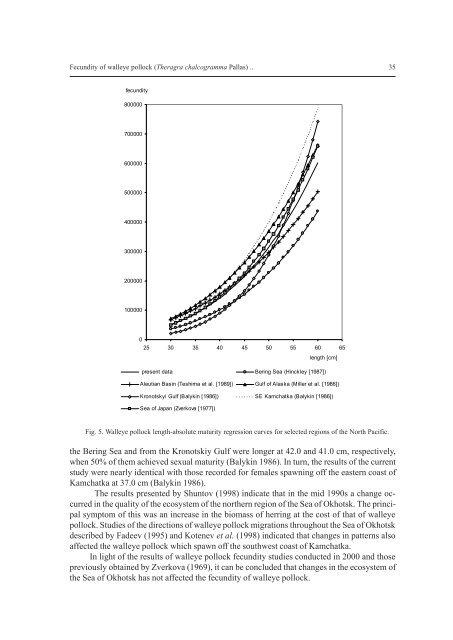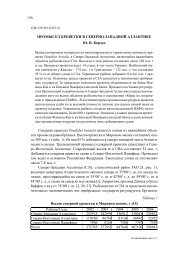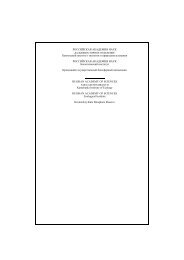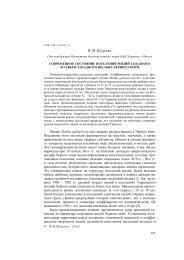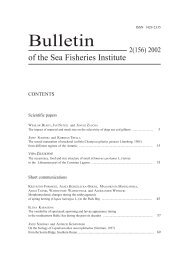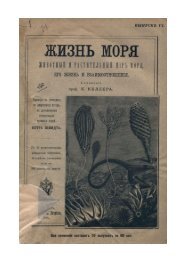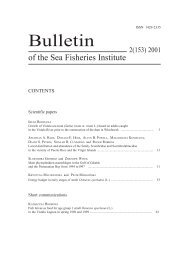Bulletin of the Sea Fisheries Institute 1 (155) 2002 - CEEMaR
Bulletin of the Sea Fisheries Institute 1 (155) 2002 - CEEMaR
Bulletin of the Sea Fisheries Institute 1 (155) 2002 - CEEMaR
You also want an ePaper? Increase the reach of your titles
YUMPU automatically turns print PDFs into web optimized ePapers that Google loves.
Fecundity <strong>of</strong> walleye pollock (Theragra chalcogramma Pallas) .. 35<br />
fecundity<br />
800000<br />
700000<br />
600000<br />
500000<br />
400000<br />
300000<br />
200000<br />
100000<br />
0<br />
25 30 35 40 45 50 55 60 65<br />
length [cm]<br />
present data Bering <strong>Sea</strong> (Hinckley [1987])<br />
Aleutian Basin (Teshima et al. [1989]) Gulf <strong>of</strong> Alaska (Miller et al. [1986])<br />
Kronotskyi Gulf (Balykin [1986]) SE Kamchatka (Balykin [1986])<br />
<strong>Sea</strong> <strong>of</strong> Japan (Zverkova [1977])<br />
Fig. 5. Walleye pollock length-absolute maturity regression curves for selected regions <strong>of</strong> <strong>the</strong> North Pacific.<br />
<strong>the</strong> Bering <strong>Sea</strong> and from <strong>the</strong> Kronotskiy Gulf were longer at 42.0 and 41.0 cm, respectively,<br />
when 50% <strong>of</strong> <strong>the</strong>m achieved sexual maturity (Balykin 1986). In turn, <strong>the</strong> results <strong>of</strong> <strong>the</strong> current<br />
study were nearly identical with those recorded for females spawning <strong>of</strong>f <strong>the</strong> eastern coast <strong>of</strong><br />
Kamchatka at 37.0 cm (Balykin 1986).<br />
The results presented by Shuntov (1998) indicate that in <strong>the</strong> mid 1990s a change occurred<br />
in <strong>the</strong> quality <strong>of</strong> <strong>the</strong> ecosystem <strong>of</strong> <strong>the</strong> nor<strong>the</strong>rn region <strong>of</strong> <strong>the</strong> <strong>Sea</strong> <strong>of</strong> Okhotsk. The principal<br />
symptom <strong>of</strong> this was an increase in <strong>the</strong> biomass <strong>of</strong> herring at <strong>the</strong> cost <strong>of</strong> that <strong>of</strong> walleye<br />
pollock. Studies <strong>of</strong> <strong>the</strong> directions <strong>of</strong> walleye pollock migrations throughout <strong>the</strong> <strong>Sea</strong> <strong>of</strong> Okhotsk<br />
described by Fadeev (1995) and Kotenev et al. (1998) indicated that changes in patterns also<br />
affected <strong>the</strong> walleye pollock which spawn <strong>of</strong>f <strong>the</strong> southwest coast <strong>of</strong> Kamchatka.<br />
In light <strong>of</strong> <strong>the</strong> results <strong>of</strong> walleye pollock fecundity studies conducted in 2000 and those<br />
previously obtained by Zverkova (1969), it can be concluded that changes in <strong>the</strong> ecosystem <strong>of</strong><br />
<strong>the</strong> <strong>Sea</strong> <strong>of</strong> Okhotsk has not affected <strong>the</strong> fecundity <strong>of</strong> walleye pollock.


